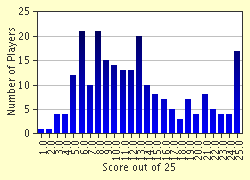Quiz Answer Key and Fun Facts
1. In Ancient times the territory of present-day Bosnia and Herzegovina was part of which Roman province?
2. What powerful Slavic tribes settled in the territory of Bosnia and Herzegovina during 6th and 7th centuries AD?
3. Who ruled the parts of territory of present-day Bosnia in the 8-13 centuries AD (and in what order)?
4. What is the name of the longest-lasting Bosnian medieval dynasty?
5. The greatest Bosnian king, Tvrtko I, ruled what other countries besides Bosnia?
6. A strong religious movement blossomed in medieval Bosnia, characterized as "dualistic [Manichean] heretics" by Pope. What were its adherents called?
7. When did Bosnia fall to Ottoman Turks?
8. The elite corps of Ottoman army, composed of Christian youths, forcibly converted to Islam, often taken by force as young boys from the Balkan provinces, were called what?
9. What Bosnian 'kapetan' (local hereditary official) rose local Bosnian army against Sultan Mahmud II in 1831?
10. Who crushed a major Christian, mostly Serb, rebellion in 1850-51 against Ottoman rule?
11. Under Ottoman occupation system, non-Muslims were deprived of many rights, such as owning land, bearing arms, trading or being elected to official posts. What were these deprived people called?
12. The beginning of new uprising of Bosnian non-Muslim population in 1875 against Ottoman rule, which lead to liberation of almost all of Bosnia and Herzegovina, except major cities, broke out where?
13. Where did Austria-Hungary got a mandate to occupy Bosnia and Herzegovina as a "protectorate"?
14. The new occupying power immediately strived to create a new Bosnian national consciousness, in order to undermine the local Christians' sense of identity as Serbs and Croats. Who was in charge of this project?
15. Austria-Hungary occupied Bosnia and Herzegovina with mandate to bring peace and stability. However, Austria-Hungary suddenly annexed it later. When was this?
16. Archduke Franz Ferdinand was shot dead in Sarajevo by Gavrilo Princip, a young Serb from the 'Young Bosnia' clandestine organization. When exactly was this?
17. The Yugoslav Committee and the Serbian government-in-exile decided in July 1917 to create a single democratic South Slav state, including Bosnia and Herzegovina. Where did they decide this?
18. After creation of Kingdom of Serbs, Croats and Slovenes, Bosnia and Herzegovina retained no formal status of its own.
19. After the Axis invasion of Yugoslavia, the entire Bosnian territory was absorbed into what country?
20. Two organized and strong resistance movements against Ustashas and Nazis emerged. Name them!
21. In November of 1943, in still occupied country, Tito's anti-Fascist movement decided to reorganize post-war Yugoslavia into federation of six republics, thus historically re-creating Bosnia and Herzegovina. In what Bosnian town this historical meeting took place?
22. On what date was Sarajevo liberated from Axis occupation?
23. When was the first decree issued to the effect that the term "Muslim" denotes "national" rather then a religious identity in Bosnia?
24. When was the referendum on the independence of Bosnia and Herzegovina held?
25. U.S.-sponsored peace talks in Dayton, Ohio, in November 1995, ended the three and a half years of civil war and created Bosnia as a country consisting of two separate entities. Name them!
Source: Author
St Sava Jr.
This quiz was reviewed by FunTrivia editor
bloomsby before going online.
Any errors found in FunTrivia content are routinely corrected through our feedback system.

